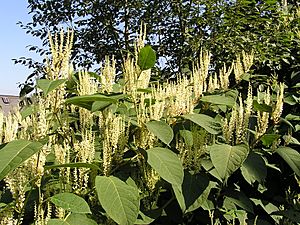Japanese knotweed facts for kids
Quick facts for kids Japanese knotweed |
|
|---|---|
 |
|
| Scientific classification | |
| Synonyms | |
|
Japanese knotweed is a very strong and fast-growing plant. It is known for causing problems because it can grow almost anywhere and push out other plants. This plant is originally from parts of Asia, like Japan, China, and Taiwan. But now, it has spread to many other countries, including the United States, where it is considered an invasive plant. This means it's a plant that doesn't belong there and can harm the local environment.
Contents
What is Japanese Knotweed?
Japanese knotweed is a type of perennial herbaceous plant. This means it's a plant that dies back to the ground each winter but grows back from its roots every spring. It doesn't have a woody stem like a tree or a bush. It can grow very tall, sometimes over 10 feet (3 meters) in a single growing season!
Where Does Japanese Knotweed Grow Naturally?
This plant comes from East Asia. You can find it growing in countries like Japan, China, and Taiwan. In its home environment, other plants and insects help keep its growth in check, so it doesn't cause as many problems.
Why is Japanese Knotweed a Problem?
Outside of its native home, Japanese knotweed is a big problem because it grows so fast and strong. It can quickly take over areas, blocking out sunlight for other plants and stopping them from growing. This can harm the natural environment and reduce the number of different plant and animal species in an area. It can even grow through cracks in pavement and foundations, causing damage to buildings and roads.
What Does Japanese Knotweed Look Like?
Japanese knotweed has some unique features that make it easy to spot.
Stems and Leaves
Its stems look a bit like bamboo, with hollow sections and purple speckles. They are usually reddish-brown when young and turn green as they grow. The leaves are heart-shaped or shield-shaped and are usually bright green. They grow in a zigzag pattern along the stem.
Flowers and Seeds
In late summer or early autumn, Japanese knotweed produces small, creamy-white flowers that grow in clusters. These flowers attract bees and other insects. After flowering, the plant can produce seeds, but it mostly spreads in other ways.
Roots and Rhizomes
The most important part of Japanese knotweed is its root system. It has very strong, deep, and wide-spreading underground stems called rhizomes. Even a tiny piece of a rhizome can grow into a whole new plant. This makes it very hard to get rid of once it starts growing.
How Does Japanese Knotweed Spread?
Japanese knotweed mainly spreads through its rhizomes. If pieces of the plant's stem or root are broken off and moved, they can easily start new plants. This can happen through:
- Moving soil: If soil containing knotweed pieces is moved, the plant can spread to new places.
- Water: Pieces of the plant can float down rivers and streams and start new patches downstream.
- Garden waste: If people throw away knotweed cuttings, they can take root and grow.
How is Japanese Knotweed Controlled?
Because Japanese knotweed is so hard to get rid of, controlling it often takes a lot of effort.
Different Control Methods
- Chemical treatments: Special weed killers can be used to kill the plant, but it often takes several years of treatment.
- Digging it out: This is very difficult because even small pieces of root left behind can regrow. It also creates a lot of waste that needs to be disposed of carefully.
- Biological control: Scientists are looking into using natural enemies, like specific insects or fungi from Japan, that only eat or harm Japanese knotweed. This is a promising way to control it without harming other plants.
Why is Control Important?
Controlling Japanese knotweed helps protect local environments and native plants. It also prevents damage to buildings and infrastructure. Many countries have laws about how to deal with this plant because of the problems it causes.
Images for kids
-
This antique locomotive at Beekbergen, Netherlands, is overgrown by knotweed. A few years before, it was free of knotweed.
See also
 In Spanish: Hierba nudosa japonesa para niños
In Spanish: Hierba nudosa japonesa para niños








